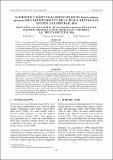Por favor, use este identificador para citar o enlazar este ítem:
https://hdl.handle.net/20.500.12958/3450| Título : | Alimento y hábitos alimentarios de Paralonchurus peruanus (suco) procedente de la pesca artesanal, Región La Libertad, 2016 |
| Otros títulos : | Feed and eating habits of Paralonchurus peruanus (Peruvian banded croaker) from artisanal fisheries, La Libertad Region, 2016 |
| Autor : | Pérez, LLeyla Atoche Suclupe, Dennis Culquichicón, Zoila |
| Palabras clave : | Paralonchurus peruanus;Peces;Pesca Artesanal;Perú - La Libertad |
| Fecha de publicación : | 2020 |
| Editorial : | Instituto del Mar del Perú |
| Citación : | Bol Inst Mar Perú. 35(1) 2020, p. 96-105 |
| Citación : | Boletín IMARPE 35(1), 2020; |
| Resumen : | Se determinó el alimento y hábitos alimentarios de Paralonchurus peruanus procedente de la pesca artesanal en la Región La Libertad durante el 2016. Se trabajó con una muestra de 354 estómagos llenos. Se determinó la dinámica trófica a través del análisis de los índices de vacuidad (IV.) y repleción (IR). En la composición trófica de la dieta se utilizaron los métodos frecuencia de ocurrencia, numérico y gravimétrico, así como el método combinado a través de la estimación del índice de importancia relativa (IRI). Se reconocieron 18 presas, clasificadas en 6 filos y 8 clases, siendo la más importante Pherusa sp. Según IRI las presas más importantes fueron Pherusa sp. (41,2%) y Arenicola marina (20,3%). Se concluye que Paralonchurus peruanus, es una especie carnívora, con preferencia por los poliquetos Pherusa sp., Arenicola marina y Lumbrineris tetraura y ofiuroideos del género Ophiactis. ABSTRACT: The feed and eating habits of Paralonchurus peruanus caught by artisanal fisheries in La Libertad Region during 2016 were determined. A sample of 354 full stomachs was analyzed. The trophic dynamics were determined through the analysis of the vacuity index (VI) and the repletion index (RI). The following methods were used for the trophic composition of the diet: frequency of occurrence, numerical and gravimetric, as well as the combined method through the estimation of the relative importance index (RII). A total of 18 preys were recognized, classified in 6 phyla and 8 classes, with Pherusa sp. being the most important. The most important prey, based on RII, were Pherusa sp. (41.2%), and Arenicola marina (20.3%). In conclusion, Paralonchurus peruanus is a carnivorous species, with a preference for the polychaetes Pherusa sp., Arenicola marina, and Lumbrineris tetraura and ophiuroids of genus Ophiactis. |
| URI : | https://hdl.handle.net/20.500.12958/3450 |
| ISBN : | 04587766 |
| Aparece en las colecciones: | Boletín 35(1), 2020 |
Ficheros en este ítem:
| Fichero | Descripción | Tamaño | Formato | |
|---|---|---|---|---|
| Boletin 35-1 articulo10.pdf | 478,56 kB | Adobe PDF |  Visualizar/Abrir |
Este ítem está sujeto a una licencia Creative Commons Licencia Creative Commons

